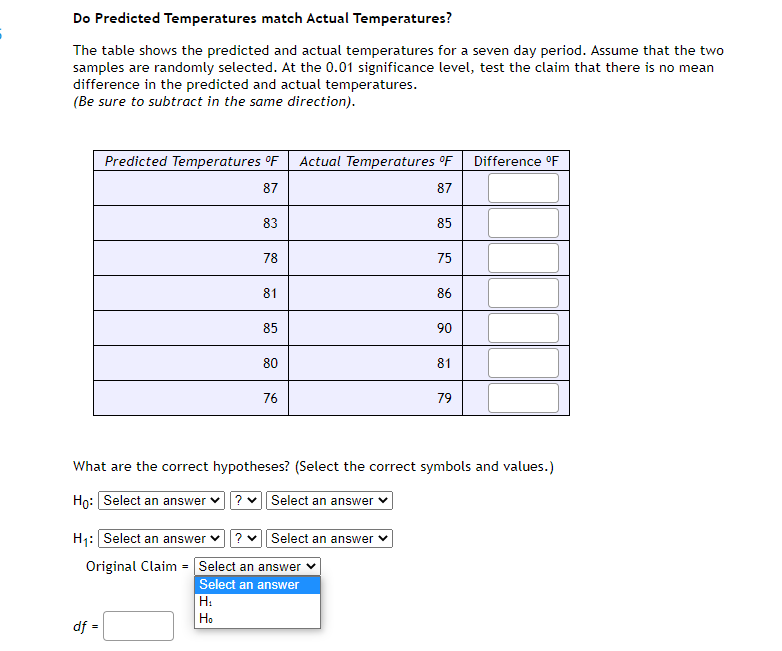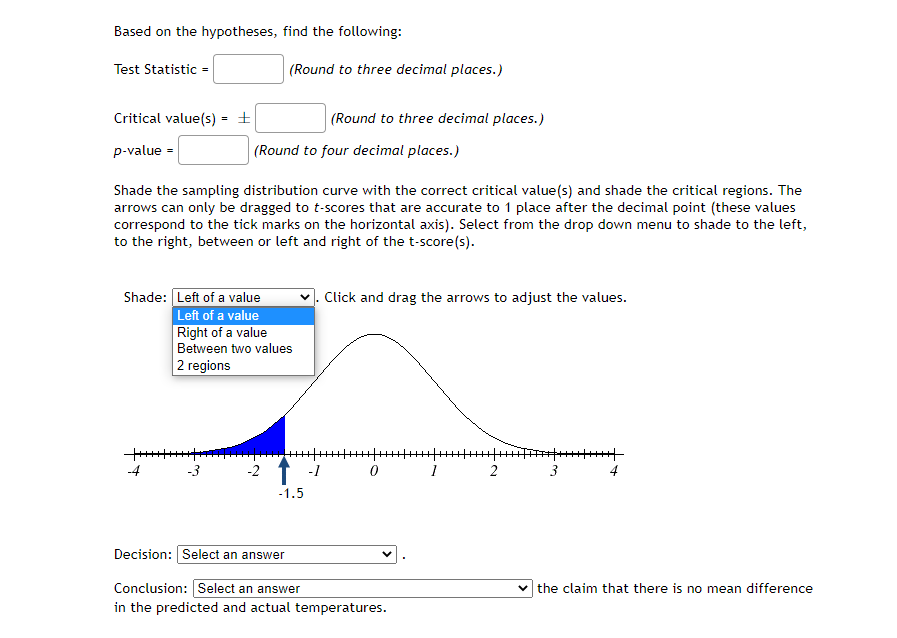The table shows the predicted and actual temperatures for a seven day period. Assume that the two samples are randomly selected. At the 0.01 significance level, test the claim that there is no mean difference in the predicted and actual temperatures. (Be sure to subtract in the same direction).
The table shows the predicted and actual temperatures for a seven day period. Assume that the two samples are randomly selected. At the 0.01 significance level, test the claim that there is no mean difference in the predicted and actual temperatures. (Be sure to subtract in the same direction).
MATLAB: An Introduction with Applications
6th Edition
ISBN:9781119256830
Author:Amos Gilat
Publisher:Amos Gilat
Chapter1: Starting With Matlab
Section: Chapter Questions
Problem 1P
Related questions
Question

Transcribed Image Text:Do Predicted Temperatures match Actual Temperatures?
The table shows the predicted and actual temperatures for a seven day period. Assume that the two
samples are randomly selected. At the 0.01 significance level, test the claim that there is no mean
difference in the predicted and actual temperatures.
(Be sure to subtract in the same direction).
Predicted Temperatures °F Actual Temperatures °F
Difference °F
87
87
83
85
78
75
81
86
85
90
80
81
76
79
What are the correct hypotheses? (Select the correct symbols and values.)
Họ: Select an answer v? Select an answer
H1: Select an answer
? v Select an answer
Original Claim = Select an answer
Select an answer
H:
Ho
df =

Transcribed Image Text:Based on the hypotheses, find the following:
Test Statistic =
(Round to three decimal places.)
Critical value(s) = ±
(Round to three decimal places.)
p-value =
(Round to four decimal places.)
Shade the sampling distribution curve with the correct critical value(s) and shade the critical regions. The
arrows can only be dragged to t-scores that are accurate to 1 place after the decimal point (these values
correspond to the tick marks on the horizontal axis). Select from the drop down menu to shade to the left,
to the right, between or left and right of the t-score(s).
Shade: Left of a value
. Click and drag the arrows to adjust the values.
Left of a value
Right of a value
Between two values
2 regions
-4
-3
-2 Т -1
1
2
3
4
-1.5
Decision: Select an answer
Conclusion: Select an answer
in the predicted and actual temperatures.
v the claim that there is no mean difference
Expert Solution
This question has been solved!
Explore an expertly crafted, step-by-step solution for a thorough understanding of key concepts.
Step by step
Solved in 2 steps with 2 images

Knowledge Booster
Learn more about
Need a deep-dive on the concept behind this application? Look no further. Learn more about this topic, statistics and related others by exploring similar questions and additional content below.Recommended textbooks for you

MATLAB: An Introduction with Applications
Statistics
ISBN:
9781119256830
Author:
Amos Gilat
Publisher:
John Wiley & Sons Inc

Probability and Statistics for Engineering and th…
Statistics
ISBN:
9781305251809
Author:
Jay L. Devore
Publisher:
Cengage Learning

Statistics for The Behavioral Sciences (MindTap C…
Statistics
ISBN:
9781305504912
Author:
Frederick J Gravetter, Larry B. Wallnau
Publisher:
Cengage Learning

MATLAB: An Introduction with Applications
Statistics
ISBN:
9781119256830
Author:
Amos Gilat
Publisher:
John Wiley & Sons Inc

Probability and Statistics for Engineering and th…
Statistics
ISBN:
9781305251809
Author:
Jay L. Devore
Publisher:
Cengage Learning

Statistics for The Behavioral Sciences (MindTap C…
Statistics
ISBN:
9781305504912
Author:
Frederick J Gravetter, Larry B. Wallnau
Publisher:
Cengage Learning

Elementary Statistics: Picturing the World (7th E…
Statistics
ISBN:
9780134683416
Author:
Ron Larson, Betsy Farber
Publisher:
PEARSON

The Basic Practice of Statistics
Statistics
ISBN:
9781319042578
Author:
David S. Moore, William I. Notz, Michael A. Fligner
Publisher:
W. H. Freeman

Introduction to the Practice of Statistics
Statistics
ISBN:
9781319013387
Author:
David S. Moore, George P. McCabe, Bruce A. Craig
Publisher:
W. H. Freeman